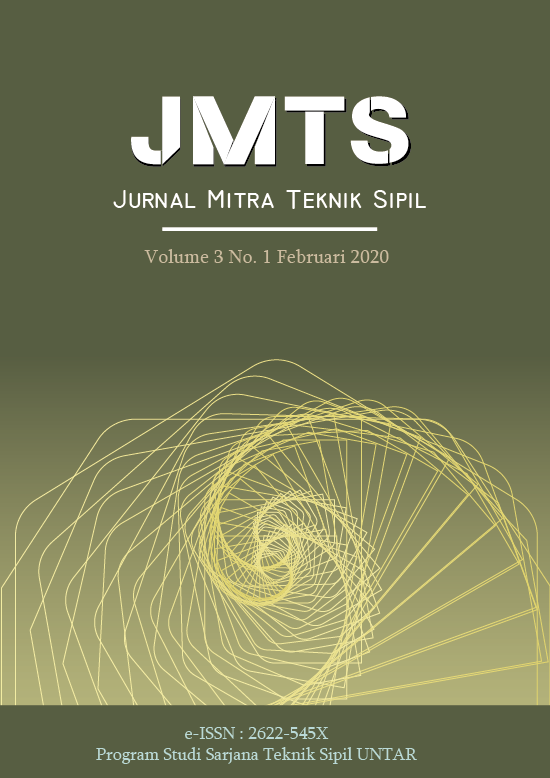WASTE MATERIAL BETON PADA PROYEK KONSTRUKSI DI JAKARTA
Main Article Content
Abstract
Waste material can be interpreted as undesirable or valueless material for ordinary or primary purposes in the manufacture or use. This study aims to determine how much the remaining material that occurs in concrete construction work and the form of handling carried out to prevent material waste. The purpose of this study was to determine how much material waste occurred, losses caused by material waste and to find out the cause of material waste. The research sample taken was a low rise building project in Jakarta and its surroundings. The method used in data collection is field observations and interviews. Data obtained in the form of Bill of Quantity, working drawings, or monthly reports. Data analysis using quantitative analysis to determine the largest type of material and losses in concrete work calculated by the regression method assisted by the SPSS program to get the large losses that occur in concrete construction work. The results obtained are the largest residual construction material in concrete construction is 7.05% for low rise building projects in Jakarta and surrounding areas and losses (%) that have a regression such as the following Y = -1.640 + 0.669 X1 + 0.481 X2 + 0.098 X3.
Abstrak
Waste material can be interpreted as undesirable or valueless material for ordinary or primary purposes in the manufacture or use. This study aims to determine how much the remaining material that occurs in concrete construction work and the form of handling carried out to prevent material waste. The purpose of this study was to determine how much material waste occurred, losses caused by material waste and to find out the cause of material waste. The research sample taken was a low rise building project in Jakarta and its surroundings. The method used in data collection is field observations and interviews. Data obtained in the form of Bill of Quantity, working drawings, or monthly reports. Data analysis using quantitative analysis to determine the largest type of material and losses in concrete work calculated by the regression method assisted by the SPSS program to get the large losses that occur in concrete construction work. The results obtained are the largest residual construction material in concrete construction is 7.05% for low rise building projects in Jakarta and surrounding areas and losses (%) that have a regression such as the following Y = -1.640 + 0.669 X1 + 0.481 X2 + 0.098 X3.
Article Details
References
Bossink, B.A.G., H.J.H Browers. Construction waste: Quantification And Source Evaluation. Journal of Construction Engineering and Management. Vol.122. No.1 Maret 1996: 55-60
Gavilan, R.M., L.E Bernold. 1994. Source evaluation of solid waste in building construction. Journal of Construction Engineering and Management. Vol. 132 No.11. September 1994: 536 – 552
Illingworth, J.R. Waste in the construction process, 1998.
Intan, S. Analisa Dan Evaluasi Sisa Material Konstruksi: Sumber Penyebab, Kuantitas, Dan Biaya. Civil Engineering Dimension, Vol. 7. No.1 Maret 2005: 36 – 45
Skoyles, E.R., 1987, Waste Prevention On Site, Gread Britain: Butler & Tanner Ltd. 1987: 18.
Waty, M., Gondokusumo, O., Sulistio, H, et al. Modeling of Waste Material Costs on Road Construction Projects International Journal of Engineering & Technology, Vol. 7 No. 2 2018 474-477
Yayasan Lembaga Penyelidikan Masalah Bangunan, PBI 1971: Peraturan Beton Bertulang Indonesia. Bandung: Yayasan Lembaga Penyelidikan Masalah Bangunan, 1971



